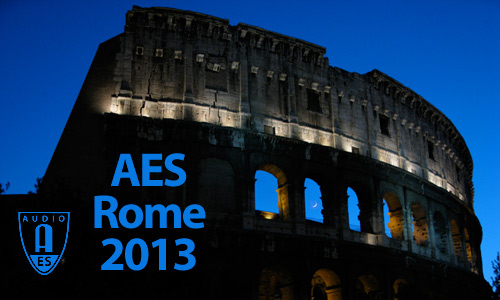
AES Rome 2013
Engineering Brief EB1
EB1 - E-Brief Posters—Part 1
Saturday, May 4, 11:00 — 12:30 (Foyer)
EB1-1 Timecode-Aware Loudness Monitoring: Accelerate Engineers’ Everyday Workflow—Arnaud Laborie, Trinnov Audio - Bry sur Marne, France; Samuel Tracol, Trinnov Audio - Bry sur Marne, France; Arnaud Destinay, Trinnov Audio - Bry sur Marne, France; Jacques Di Giovanni, Trinnov Audio - Bry sur Marne, France
While EBU R-128 loudness normalization is in the process of being adopted by a majority of European countries, most real-time loudness meters aren’t still completely adapted to mixing engineers’ workflows, as continuous project measurements are always required to keep consistent loudness values. By slaving the loudness measurement to an incoming time code, every loudness and true peak values are constantly recorded and time stamped, allowing their calculation at any time. Engineers no longer need to manually pause, resume, or even start a measurement over to keep a relevant loudness monitoring.
Engineering Brief 78 (Download now)
EB1-2 Control of the Audio Signal Using Thermal Parameter for Protection of the Voice Coil—Oanjin Kim, Samsung Electronics Co., Ltd. - Suwon, Korea; Keeyeong Cho, Samsung Electronics Co., Ltd. - Suwon, Korea; Jongwoo Kim, Samsung Electronics Co., Ltd. - Suwon, Korea
This engineering brief presents a procedure for a signal processing method to protect a voice coil from overheating. The basic concept is that of estimating temperature of the voice coil with heat transfer model and controlling the output level before the voice coil is burnt. This paper mainly focuses on the calculation method and various considerations in level control. A basic heat transfer model and a commonly used method in calculation of the thermal parameters are introduced.
Engineering Brief 79 (Download now)
EB1-3 Automatic Segmentation of Concert Recordings via a Heuristic Approach—Andrew Ayers, University of Miami - Coral Gables, FL, USA
In the age of digital recordings, many institutions maintain large databases of concert recordings. While segmentation of these concert recordings for mastering and production is a time-consuming task for humans, this paper presents a novel heuristic algorithm to automate that process. Building on other work in audio segmentation, technique from the music informatics community is used to detect events, classify them, and segment entire concert recordings unsupervised. A brief review of previous work and the methodology used in this approach are provided, as well as the results obtained on a corpus of sixteen concerts.
Engineering Brief 80 (Download now)
EB1-4 Simulation of a Near Field Loudspeaker System on Headphones—Erich Meier, amoenus audio by Erich Meier - Bern, Switzerland
The vast majority of recorded music is produced for reproduction via loudspeakers positioned at the standard 60° stereo triangle. To achieve the same sound impression on headphones with its near-field 180° transducer positions, the sound of the standard stereo 60° triangle has to be simulated. We describe a circuit using different serial and parallel delay-and-filter paths for direct and cross-feed channels, with the goal to achieve accurate near-field loudspeaker-sound and also a good externalized localization.
Engineering Brief 81 (Download now)
EB1-5 Influence of First Reflections in Listening Room on Subjective Listener Impression of Reproduced Sound—Hidetaka Imamura, Tokyo University of the Arts - Tokyo, Japan; Atsushi Marui, Tokyo University of the Arts - Adachi-ku, Tokyo, Japan; Toru Kamekawa, Tokyo University of the Arts - Tokyo, Japan; Masataka Nakahara, SONA Corp. - Tokyo, Japan
This study investigated the perceptual factors regarding room acoustics such as spatial impression and timbre preferences, with focus on the arrival direction and pattern of the early reflections. Impulse responses were recorded with varying wall reflection and evaluated in a subjective test. Although no significant difference in timbre preferences and some evaluation terms were found in subjective listening test, the variation of early reflections did significantly influence listeners spatial impression. The method and results of the analysis is reported in the presentation.
Engineering Brief 82 (Download now)
EB1-6 Workload Estimation for Low-Delay Segmented Convolution—Malte Spiegelberg, HAW Hamburg - Hamburg, Germany
Zero-delay convolution usually follows a hybrid approach with convolution processing steps in both the time and the frequency domain [Gardner, J. Audio Eng. Soc., vol. 43, 127-136 (1995 Mar.)]. Implementations are likely to ask for dynamic coding, and related workload estimations are focused on efficiency and are limited to the hybrid approach. This paper considers simpler implementations of segmented convolution that work in the frequency domain only and that achieve acceptable low delay for real-time applications when processing several seconds of impulse-response in FIR mode. Workload and memory demand are estimated for this approach in the context of likely application parameters.
Engineering Brief 88 (Download now)
